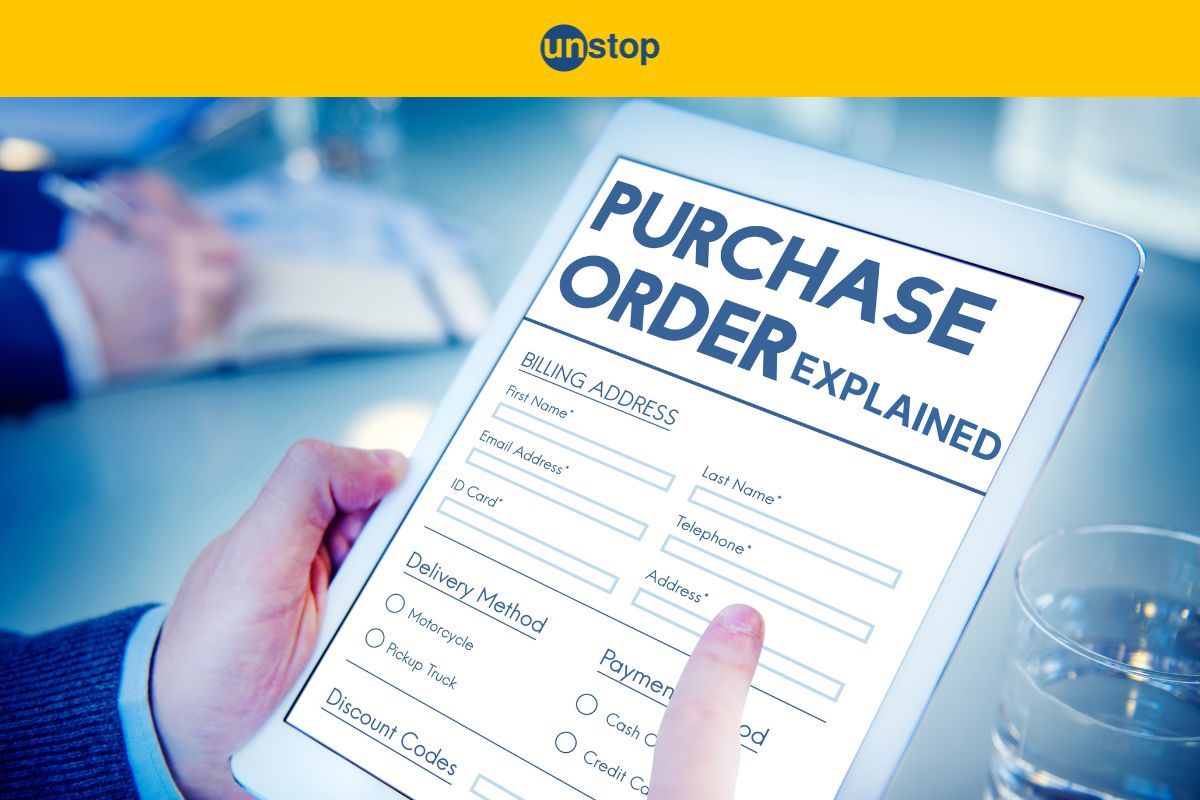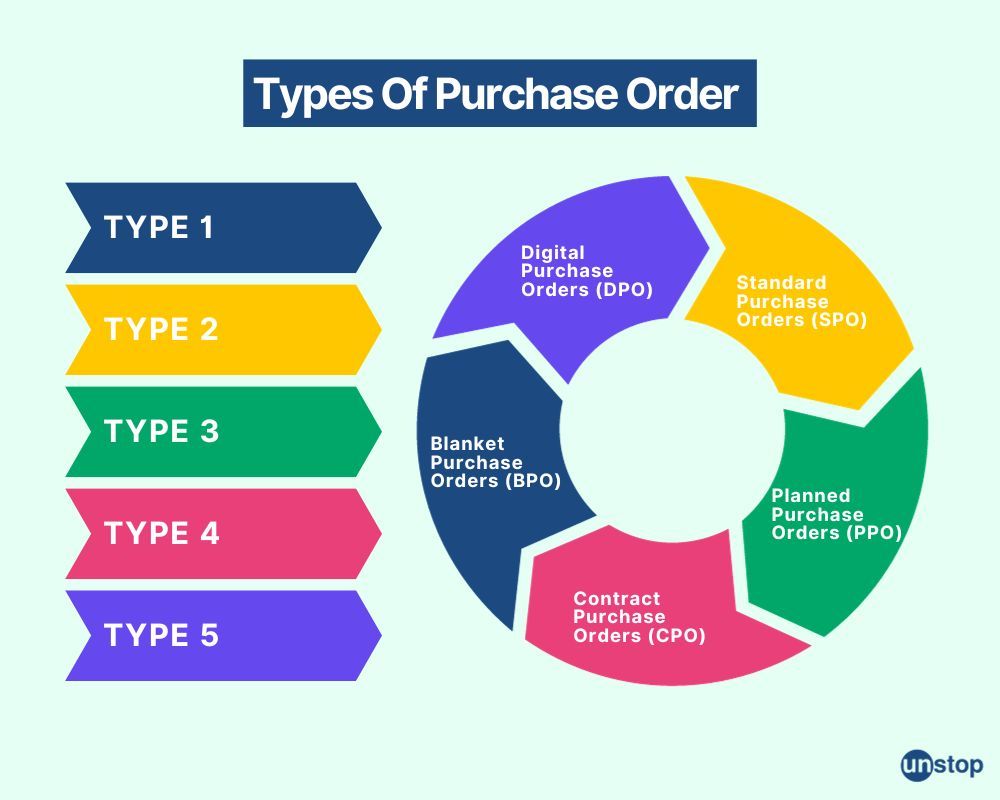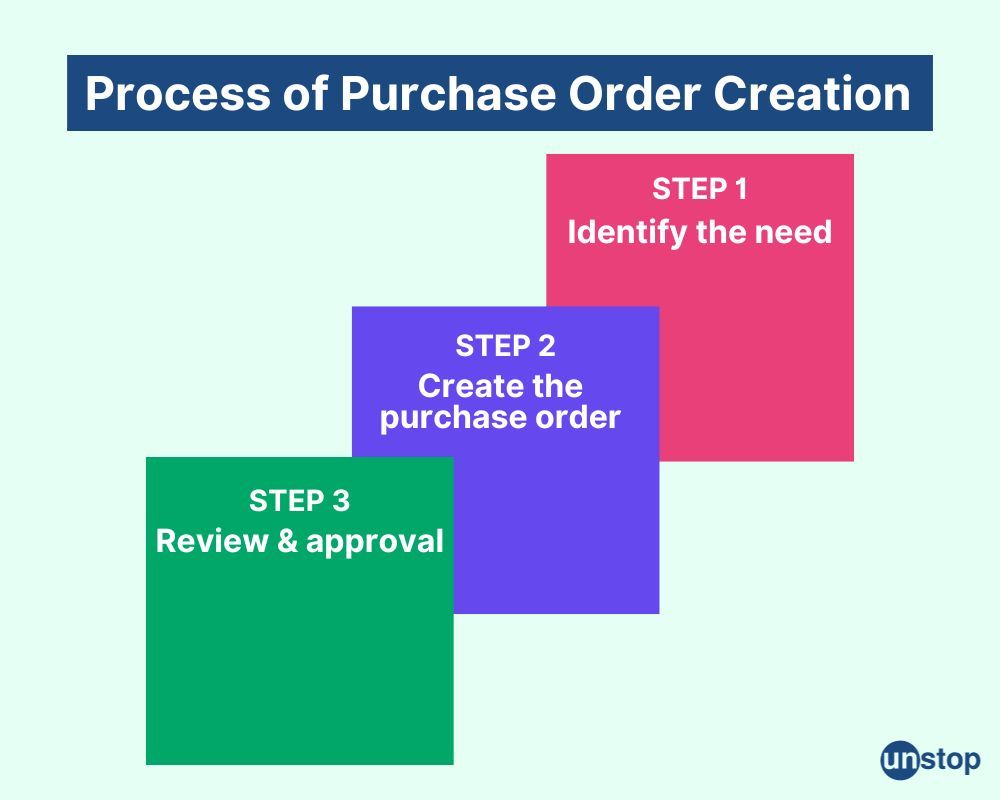- Purchase Order Definition & Its Components
- Creating A Purchase Order
- Types Of Purchase Orders
- Process Of Purchase Order
- Examples Of Purchase Order
- How Suppliers Use Purchase Orders
- Handling Discrepancies In Purchase Orders
- Best Practices For Handling Purchase Order
- Difference Between Purchase Orders & Invoices
- Frequently Asked Questions (FAQs)
Purchase Order: Definition, Types, Process & Examples

A purchase order plays a vital role in ensuring smooth and efficient procurement processes. It provides clarity and transparency by clearly stating what is being ordered when it is needed, and at what price. This, in turn, helps both the buyer and the seller to have a clear understanding of their responsibilities and expectations.
Purchase Order Definition & Its Components
A purchase order is a document used in business transactions to request and authorize the purchase of goods or services from a supplier. It acts as a legal contract between the buyer and the supplier, outlining the details of the transaction.
Here are some key points to help you understand purchase orders better:
Components Of A Purchase Order
A typical purchase order includes various components that provide essential information about the transaction. The notable components in the purchase order are listed below:
Buyer Information
Buyer information is an essential component of a purchase order. It comprises the name, address, and contact details of the buyer. This information is crucial for the seller to identify and communicate with the buyer effectively. Additionally, any specific instructions for delivery or invoicing can be included in this section.
For example, the buyer may provide detailed directions for shipping or request a specific method of payment.
By including buyer information in a purchase order, both parties can ensure smooth communication and accurate fulfillment of the order.
Supplier Information
Supplier information in a purchase order refers to the details of the company or individual from whom the goods or services are being ordered. This information typically includes the supplier's name, address, contact details, and any relevant account numbers.
The supplier information is essential for ensuring that the order is sent to the correct recipient and that any necessary communication or documentation can be easily facilitated.
By including accurate and up-to-date supplier information in a purchase order, businesses can ensure smooth and efficient transactions with their suppliers.
Item Details
The item details in a purchase order provide specific information about the products or services being ordered. This includes the quantity of each item, the description or name of the item, the unit price, and any additional specifications or requirements.
The item details help ensure that the correct products or services are ordered and that there is clarity on what is expected. It also serves as a reference for both the buyer and the seller to track and verify the items being purchased.
The item details in a purchase order are crucial for accurate and efficient procurement processes.
Creating A Purchase Order
To create a purchase order, gathering the necessary information, such as vendor details, item specifications, and quantities, is needed. Then, input this information into a purchase order template or software system and review it before sending it to the vendor for processing.
Let us study some of the key information required in creating a purchase order as listed below:
Highlighting Vendor's Name & Contact Information
To create a purchase order, there are some key pieces of information you need to include. First and foremost, you should clearly state the vendor's name and contact information at the top of the document.
This ensures that the purchase order is directed to the correct supplier. It's important to provide your own company's details, including your business name, address, and contact information.
Specifying The Date On Which Purchase Order Is Created
Next, you'll want to specify the date on which the purchase order is being created. This helps both parties keep track of when the order was initiated.
Be sure to assign a unique identification number or code to each purchase order. This makes it easier to reference and track your records.
Providing Detailed Information About The Item Or Products
One crucial aspect of creating a purchase order is providing detailed information about the items or products you wish to procure. For each item, include its name or description along with any relevant specifications such as size, color, or model number.
Types Of Purchase Orders
Purchase orders are of different types. Businesses can choose any of the types as per their requirement to effectively streamline their purchasing process and ensure efficient transactions.

Let's explore some of the types of purchase orders in detail:
Blanket Purchase Orders (BPO)
A blanket purchase order (BPO) is a type of purchase order that allows businesses to streamline their procurement process by consolidating multiple orders into a single agreement with a supplier. BPOs are typically used for recurring purchases of goods or services over a specified period, such as a year.
Benefits Of Using Blanket Purchase Orders
Simplified Procurement Process: By using BPOs, businesses can avoid the need to create individual purchase orders for each transaction. Instead, they establish an overarching agreement with the supplier, which reduces administrative tasks and saves time.
Cost Savings: BPOs enable businesses to negotiate pricing and terms with suppliers effectively, given the volume and predictability of purchases. This ensures cost savings and improved profitability.
Improved Supplier Relationships: Establishing long-term relationships through BPOs provides businesses with ways to develop stronger connections with their suppliers. This can result in better communication, increased trust, and enhanced collaboration.
Standard Purchase Orders (SPO)
Standard Purchase Orders (SPO) are another common type of purchase order used in business transactions. They serve as a formal document that outlines the details of a specific purchase, including the items or services to be procured, quantities, prices, and delivery terms.
Let's explore the key aspects of standard purchase orders.
Benefits of Using Standard Purchase Orders
Establishes Agreement: The primary purpose of a standard purchase order is to establish a legally binding agreement between a buyer and a supplier.
Ensures Clarity & Transparency: It ensures clarity and transparency in the procurement process by documenting the specific requirements and expectations for both parties involved.
Prevents Misunderstandings & Disputes: By providing detailed information about the requested goods or services, standard purchase orders help prevent misunderstandings and disputes.
A standard purchase order typically contains essential information such as the names and contact details of both the buyer and supplier, the date of issue, unique identification numbers, billing and shipping addresses.
It also includes payment terms, delivery dates, item descriptions with corresponding quantities and unit prices, applicable taxes or discounts, if any, and total amounts.
Planned Purchase Orders (PPO)
Planned Purchase Orders (PPO) are an essential aspect of the procurement process. They provide businesses with a structured approach to managing their purchasing activities.
Let's explore some key points about PPOs:
Benefits of Using Planned Purchase Orders
Helps Streamline Procurement Process: Planned Purchase Orders help streamline the procurement process by allowing businesses to anticipate their future purchasing needs.
Plan & Prepare Upcoming Orders: By creating PPOs, businesses can estimate the costs associated with upcoming purchases, allowing them to allocate funds accordingly.
This helps prevent overspending and ensures that financial resources are allocated appropriately across various departments or projects.
This proactive approach helps avoid last-minute rush orders or delays in acquiring essential goods or services.
Contract Purchase Orders (CPO)
Contract Purchase Orders (CPO) are another type of purchase order that businesses use to streamline their procurement processes. They provide a framework for long-term agreements between a buyer and a supplier.
Benefits of Using Contract Purchase Orders
Establishes Clear Understanding: Firstly, CPO establishes a clear understanding between the parties involved, ensuring that expectations are aligned from the start. By setting out terms and conditions, delivery schedules, and pricing agreements upfront, CPOs help avoid misunderstandings or disputes later on.
Secures Favorable Pricing & Discounts: Secondly, CPOs enable buyers to secure favorable pricing and discounts by committing to larger quantities or longer-term contracts. This can result in significant cost savings over time, especially when dealing with high-value items or services.
Provides Stability & Predictability: For suppliers, CPOs provide stability and predictability in their business operations. With a contract in place, they can better plan their production schedules and allocate resources accordingly.
Digital Purchase Orders (DPO)
Digital Purchase Orders (DPO) are an efficient and streamlined way to manage the procurement process. With DPO, businesses can create, send, and track purchase orders electronically.

Benefits of Using Digital Purchase Orders
Simplifies Procurement Process: One of the key benefits of using DPO is that it simplifies the procurement process. Businesses can easily create purchase orders online by filling out a digital form. This eliminates the need for handwritten or printed purchase orders, making the process faster and more accurate.
Improved Accuracy & Efficiency: By digitizing purchase orders, businesses can significantly reduce errors that often occur with manual processes. With DPO systems in place, there is less room for mistakes in data entry or misinterpretation of handwritten information.
Summarizing Key Benefits Of Using Purchase Order
Purchase orders offer several key benefits for businesses, including increased efficiency, improved accuracy in procurement processes, and better financial control.
Here, we summarized the important key benefits of purchase order:
Helps Streamline Ordering Process
Streamlining the ordering process is made possible by using purchase orders that provide a structured and organized approach. By using purchase orders, businesses can ensure that all necessary information, such as item details, quantities, pricing, and delivery dates, are clearly documented. This helps to minimize errors and misunderstandings when placing orders with suppliers.
Improved Accuracy & Accountability
One of the primary benefits of using purchase orders is improved accuracy and accountability in procurement. With a purchase order in place, both the buyer and supplier have a clear reference point for what was agreed upon. This reduces the chances of miscommunication or disputes regarding order specifications or pricing.
Maintaining Effective Budget Control
Purchase orders play a pivotal role in maintaining effective budgeting control within an organization. By having a formalized process for approving purchases through purchase orders, businesses can keep track of their spending more effectively. This allows them to monitor expenses against their allocated budgets and make informed decisions about future purchases.
Process Of Purchase Order
The purchase order process involves several steps to ensure a smooth and efficient transaction.

Let's explore each step in detail:
Step 1: Identify the Need
Before creating a purchase order, it is crucial to identify the need for a particular product or service. This could be triggered by low inventory levels, equipment maintenance requirements, or customer demands.
Step 2: Create the Purchase Order
Once the need is identified, the next step is to create a purchase order. This document serves as an official request to suppliers for specific products or services. The purchase order typically includes details such as item descriptions, quantities, prices, delivery dates, and payment terms.
Step 3: Review & Approval
After creating the purchase order, it needs to go through a review and approval process. This ensures that all information provided is accurate and aligns with organizational policies and budgets. The purchase order may require approval from multiple stakeholders within the organization before proceeding further.
Examples Of Purchase Order
In order to ensure a better understanding of purchase orders, let us consider some examples cited below:
An example of a purchase order could be a company ordering office supplies from a vendor. The purchase order would specify the quantity of each item needed, the agreed-upon price, and the expected delivery date.
Another example could be a restaurant placing an order with a food supplier for ingredients. The purchase order would list the specific items required, the quantities needed, and any special instructions. Overall, purchase orders are essential in ensuring smooth and organized transactions between buyers and sellers.
A company may issue a purchase order to a supplier for the purchase of office supplies such as pens, paper, and printer ink. The purchase order would specify the quantity of each item needed, the agreed-upon price, and the delivery date.
How Suppliers Use Purchase Orders
Suppliers play a crucial role in the purchase order process. Let's explore how suppliers utilize purchase orders to streamline their operations and ensure smooth transactions.
Streamlining Inventory Management
One way suppliers benefit from purchase orders is by efficiently managing their inventory. When they receive a purchase order from a customer, it serves as a confirmation of the items required and quantities needed.
With this information, suppliers can effectively plan their production or procurement activities to meet the demand. By having a clear understanding of what needs to be supplied, suppliers can avoid overstocking or understocking inventory, ensuring optimal levels at all times.
Ensuring Accurate Order Fulfillment
Purchase orders also enable suppliers to ensure accurate order fulfillment. When they receive a purchase order, they have all the necessary details about the products or services requested by the customer.
This includes specifications, quantities, prices, delivery dates, and any other specific requirements.
Armed with this information, suppliers can carefully review and verify each element before proceeding with order processing.
Handling Discrepancies In Purchase Orders
In purchase orders, discrepancies can sometimes occur. It must be handled professionally. Let us see some of the ways to approach resolving these discrepancies:
Identifying Discrepancies
These discrepancies refer to any differences or inconsistencies between what was ordered and what was received. Identifying these discrepancies is crucial to ensure that the purchased items or services meet the intended requirements.
Communicating With The Supplier
Once a discrepancy is identified, it is important to communicate with the supplier promptly. This communication should be clear and concise, highlighting the specific issue and providing any relevant supporting documentation. By notifying the supplier as soon as possible, it increases the chances of resolving the discrepancy in a timely manner.
Providing Detailed Information
To effectively address discrepancies, providing detailed information about the purchase order is essential. This includes referencing the purchase order number, item descriptions, quantities, and any other pertinent details. The more specific and accurate the information provided, the easier it becomes for both parties involved to understand and rectify the discrepancy.
Identifying Causes Of Unfulfilled Purchase Orders
Understanding the reasons behind unfulfilled purchase orders is essential in addressing the issue effectively. Some common causes include supplier capacity constraints, production delays, transportation issues, and inventory shortages.
By identifying the specific cause for each unfulfilled order, businesses can take appropriate action to prevent similar occurrences in the future. This may involve finding alternative suppliers, improving forecasting methods, or implementing contingency plans to mitigate risks.
Best Practices For Handling Purchase Order
Handling purchase orders efficiently is important for businesses to streamline their procurement processes and ensure the timely delivery of goods and services.
Clear & Accurate Documentation
Clear and accurate documentation is essential when handling purchase orders. A clear understanding of the products or services being ordered, their quantities, prices, and delivery dates is crucial in business. By providing detailed information on the purchase order, potential misunderstandings can be minimized, leading to smoother transactions.
Timely Processing
Timely processing of purchase orders is crucial to maintain efficient operations. Once a purchase order is received, it should be promptly reviewed and processed to avoid any delay in procurement or production processes.

Verifying the accuracy of the information provided, checking inventory levels, and ensuring that the requested items are available or can be sourced within the required timeframe must be promptly reviewed and processed.
Effective Communication
Effective communication plays a vital role in handling purchase orders successfully. It involves clear and concise communication between buyers and suppliers regarding any changes or updates related to the order. This can include modifications to quantities, specifications, or delivery schedules.
Difference Between Purchase Orders & Invoices
Purchase orders and invoices are essentially two different documents in the procurement process, with purchase orders being a request to buy goods or services and invoices being a bill for the goods or services received. Let us look at two important key differences:
Difference In Purposes
The primary purpose of a purchase order is to initiate a transaction and provide clear instructions to the supplier regarding what needs to be delivered. The main purpose of an invoice is to notify the buyer of their financial obligation and facilitate timely payment.
Time To Create
Purchase orders are typically created before goods or services are received. They serve as a formal agreement between both parties on what will be delivered and at what cost. In contrast, invoices are generated after the delivery has been made or services have been rendered.
Conclusion
In conclusion, the process of creating a purchase order is essential for maintaining efficient and organized business operations. By following the necessary steps and including all relevant information, businesses can ensure that their orders are accurately fulfilled and that they have a record of their purchases.
The purchase order serves as a vital document for both the buyer and the seller, providing clarity and accountability throughout the procurement process. It enables businesses to track their expenses, manage inventory, and maintain strong relationships with suppliers.
Frequently Asked Questions (FAQs)
1. What is a purchase order, and why is it important in the purchasing process?
A purchase order is a document used by a business to request and authorize the procurement of goods or services from suppliers. It acts as a legal contract between the buyer and the supplier, outlining the details of the purchase, such as quantity, price, and delivery terms.
Purchase orders are essential in the purchasing process as they provide clarity and accountability for both parties involved, ensuring that the correct items are ordered at the agreed-upon price and delivered within the specified timeframe.
2. How to create a standard purchase order and what information should be included?
To create a standard purchase order, businesses typically use a purchase order form or template. The form should include essential information such as the purchase order number, date, billing and shipping addresses, and contact details of both the buyer and supplier.
It also includes item descriptions, quantities, prices, terms of payment, delivery instructions, and any applicable taxes or discounts. Including all necessary information on the purchase order helps avoid misunderstandings and disputes later on.
3. Are there different types of purchase orders, such as contract or blanket purchase orders?
Yes, there are various types of purchase orders that businesses can utilize based on their specific needs.
One type is a contract purchase order, which establishes an agreement between the buyer and supplier for recurring purchases over a specified period. This type of purchase order streamlines the procurement process by eliminating the need to create individual orders for each transaction.
Another type is a blanket purchase order, which allows businesses to make multiple purchases from a single supplier up to a predetermined limit. This type of purchase order is beneficial when there is an ongoing need for goods or services throughout a particular period.
4. How can electronic purchase orders streamline the purchasing process?
Electronic purchase orders (ePOs) can significantly streamline the purchasing process compared to traditional paper-based methods. Using an electronic system or software allows businesses to create, send, and track purchase orders digitally. It effectively eliminates the need for manual paperwork, reduces errors, and speeds up the entire procurement cycle.
Suggested reads:
- Retail Merchandising: The Ultimate Guide With Best Practices & Tips
- Retail Marketing: Types, Strategies And Examples Of Successful Market Players!
- The Difference Between Wholesale And Retail Explained (With Examples)
- Retail Pricing: Importance, Strategies, Examples & Tools
- What Is Retail & How Does It Work? Demystifying The Vital Component Of Economy
Alekhya Chakrabarty is a father, a doodler, a trivia buff, a sports fanatic and a lifelong student of marketing. Alekhya is the VP of Marketing & Growth at Unstop, the engagement and hiring platform which connects students and graduates with opportunities. He has over a decade and a half of experience in driving revenue and building brands with the likes of Nestle, HUL and ITC. He is an alumnus of IMT Ghaziabad and in his last stint he was leading the marketing function at Sunstone, a higher education startup. Alekhya has been recognised as a ‘Top Voice’ on LinkedIn for Digital Marketing & Brand Management. He runs a marketing podcast titled East India Marketing Company to drive conversations around growth, content, culture and commerce.
Login to continue reading
And access exclusive content, personalized recommendations, and career-boosting opportunities.
Subscribe
to our newsletter
















Comments
Add comment